When we were first training our dog, Baxter, we did not use treats. I’ve gotten a few questions about this when I’ve mentioned this in past articles, so today I’m finally sharing our treatless training approach.
I think the main question that people have is, “How do you get him to do what you want without treats?”
Initially, this was my question as well. However, I quickly learned that treat training is not the only option when it comes to dog training.
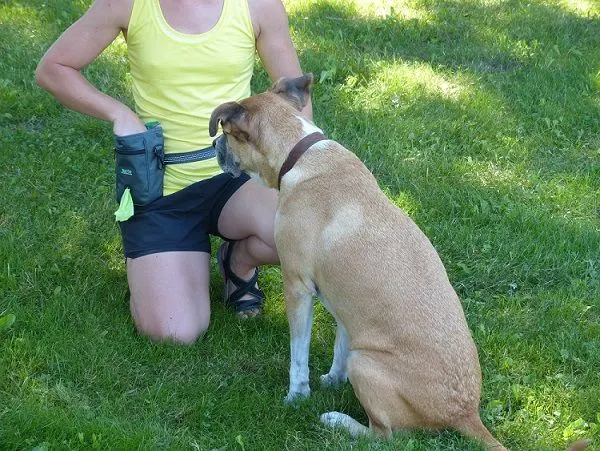
Finding the right trainer
Before we adopted Baxter we started looking for a dog trainer. Even though we weren’t adopting a puppy (Bax was 3 when he joined our family), we knew we wanted to do a training class right away.
We weren’t sure how much training he would have when he came to our family and we also thought training would be a good way to build our bond. I visited various trainers and sat in on several classes—something I wholeheartedly recommend when you’re looking for a trainer.
One of the classes I attended was a pretty typical training set-up. Multiple dogs indoors in a large room. All of the owners and dogs were ranged around the perimeter with trainers in the middle calling out instructions or moving around helping people with their dogs. Every owner was giving commands and then handing out treats.
I came home and said to my husband, Matt, “We’re not going to be able to feed him on class day. The amount of treats the dogs ate in that class was insane!”
While treat training didn’t feel like a fit for us, I didn’t actively go looking for a trainer who didn’t use treats. But that’s what we ended up with.
Our trainer’s name is Carrie Rottaris, and she runs The Canine Bond in Hamilton, Ontario. Her approach is based on establishing a really strong, mutually beneficial relationship between humans and dogs.
Carrie taught us that our job as dog owners is to give our dogs stimulation and activity and boundaries and love. In return, our dogs will give us good behaviour and fun and love. Everything is based on a foundation of respect—humans’ respect for our dogs, and dogs’ respect for their humans.
This is the biggest lesson I learned in the training classes: training is a two-way street. We give to our dogs, and they give to us.
So let’s go back to that question from the start of “how do you get your dog to do what you want him to do?” Let’s also ask, “are you doing what your dog wants to do?”
By this I’m not meaning all the fetch, all the petting, all the walks, all the chasing. But think about your dog and his needs and make sure that you’re giving him what he needs.
“I want people to pay attention to their dog and learn from their dog,” said Carrie. “My approach is about educating owners about what their dogs need and what their dogs are saying. It’s about building a foundation of trust.”
How to train your dog without treats
Our training classes started in a local park, not indoors. There were six dogs, each with one or two humans, and the other people and activities of the park. While we were in a quiet part of the park, there were obviously lots of distractions.
“There’s a big difference between outside and inside and how your dog behaves, and that’s why I do my training outside in the real world in real situations that your dog encounters,” said Carrie.
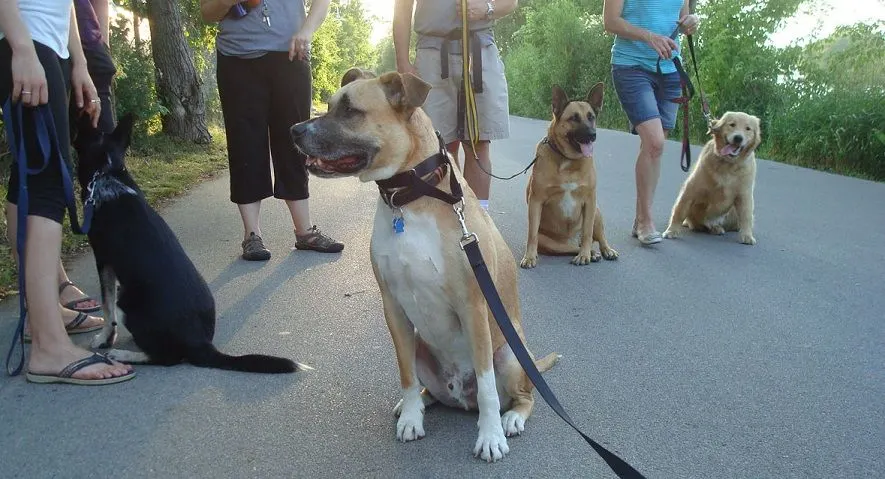
We started with basic leash work.
We walked with our dogs, working to keep the leash loose. Then we stopped, and pulled up on the leash (slowly, gently, persistently) to put the dog in a sit. Then we walked again. Two steps forward, sit. Two steps backwards, sit. Sit and look around at the park—teaching patience, calmness and obedience. Don’t move your feet to put the dog in a sit. Make the dog come to you.
Then we looped the leashes around our waists (umbilical) and practiced walking. As soon as the leash started to get tight, we changed direction (watching that we didn’t turn and run into our dogs or get tangled in the leash).
Very quickly, our dogs learned to pay attention to us. We were erratic, unpredictable humans. They had to watch because we could stop at any second. We could start walking again in any direction. They had to sit when we asked them to. They had to wait and sit for a few seconds. They had to stay with us and not investigate every scent or sight.
We had to pay attention too to what our dogs were doing and adjust and react based on how they were behaving. Give umbilical a try sometime.
It’s harder than it sounds.
Lessons learned without using treats
The “normal” approach is to treat a dog every time he sits. However, the training approach that we followed with Baxter is about setting expectations.
“Rewards are a foreign concept for dogs,” explained Carrie. “I don’t reward my two year-old for letting me put her diaper on or putting on her shoes. There are certain expectations. Having that bond and relationship is reward enough.”
She described treat training as a human invention that is unrelated to dogs and how they communicate.
She cited mother dogs who don’t “bribe” their puppies with treats and says that instead training should be about bonding, leadership and respect.
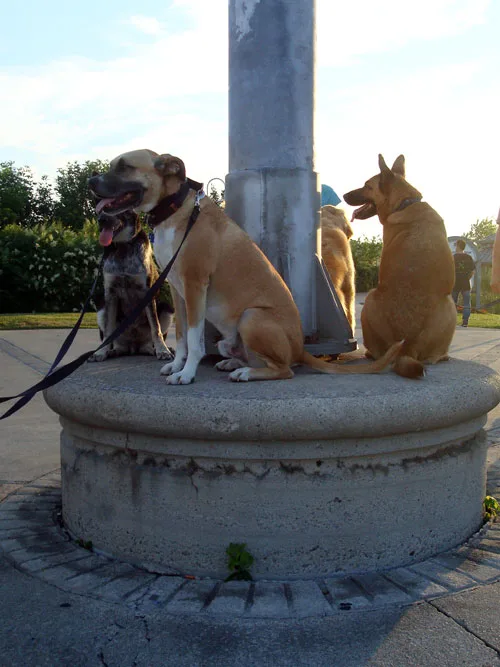
Leadership and respect tend to be loaded words in dog training these days, so I want to emphasize that our training experience was not about being alpha or dominant.
Carrie explained, “Dogs look for leaders. They want someone to set the rules. It’s not about being unfair or better than your dog. Leadership means our dog doesn’t pull us. Your relationship with your dog needs to be mutual. Maybe he’s pulling because I’m not giving him what he wants or needs. It’s a balance of respect and bonding. Give him what he needs too.”
Leash work and sits forced us to establish a foundation of respect right away. We had to be tenacious, persistent and consistent and earn our dogs’ respect.
As lessons progressed, we learned more about how to communicate with our dogs and what our dogs were saying by their reactions to us. Our bonds with our dogs grew as did our trust in each other—and as a result we progressed to more complex exercises. (Carrie’s goal was to set us up for off-leash hiking by the end of the classes.)
Training without treats involves a balance of stimulation and relaxation to meet our dog’s needs.
On the stimulation side, we challenged our dogs to focus on us, taught them confidence (classes included agility, encounters with water and visits to cities) and gave them a chance to problem solve (loose leash walking around trees and through bike racks resulted in tangles that needed to be unwound).
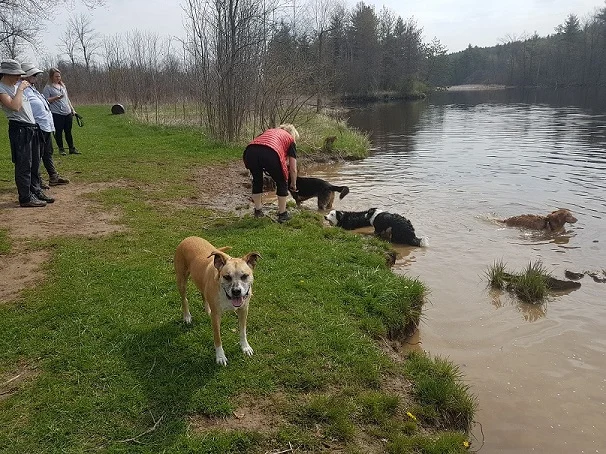
On the relaxation side, all of our classes included downtime. Opportunities for the dogs to wrestle and play with each other, a chance to sniff and investigate their surroundings, time for us to sit together and pet our dogs (Carrie taught us massage techniques to relax and bond with our dogs). Outside of class we also made time for walks and exercise along with practice.
The reward of training without treats
Training without treats is not without rewards. Giving respect back to the dogs—in stimulating experiences, a massage, freedom of an off-leash hike—is the reward.
For us, this training approach was also rewarding. I feel like I have a bond with my dog that I may not have achieved otherwise. I learned that training is about paying attention. We want our dogs to pay attention to us, but we also need to pay attention to our dogs.
When it comes to dog training, there are lots of philosophies on what is the best approach. Ultimately, the best approach is the one that works for you and your dog—the one that gives you the results you’re looking for and the one that you feel comfortable using.
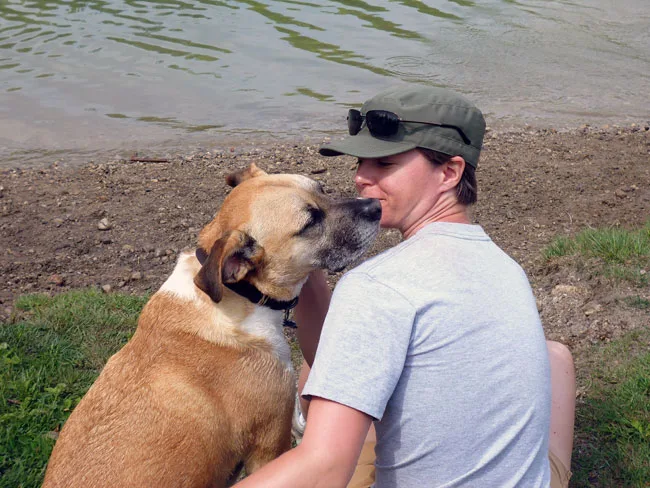
Five tips for how to train your dog without treats
1. Spend some time not talking to your dog. You’ll start observing your dog differently and learning to speak dog. This also forces your dog to tune into you in a different way and pay closer attention to what you’re doing. More on this here.
2. Leash work. Leash work. Leash work. Lead your dog and set boundaries. Change direction, change your pace, guide your dog over and around obstacles. Ask him to sit by gently pulling up on the leash. Put him on umbilical. Teach him not to pull. The leash is an excellent tool for establishing respect between you and your dog.
3. Sit is a basic tool to manage your dog. Ensuring your dog sits when asked is a key component of a respectful relationship.
4. Balance training with freedom. Our job as dog owners is to ensure our dogs are fulfilled. That means a mix of stimulation (exercise, training, work) and relaxation (free-time, playtime, petting).
5. Training is about you as well as your dog. Don’t think just about the behaviour you want your dog to give to you. Think about what you can give to your dog and how you can best meet his needs. This balance will create an incredible bond that will make for a very deep relationship between you and your dog.
What training methods have you used?
Have you ever tried to train your dog without treats?
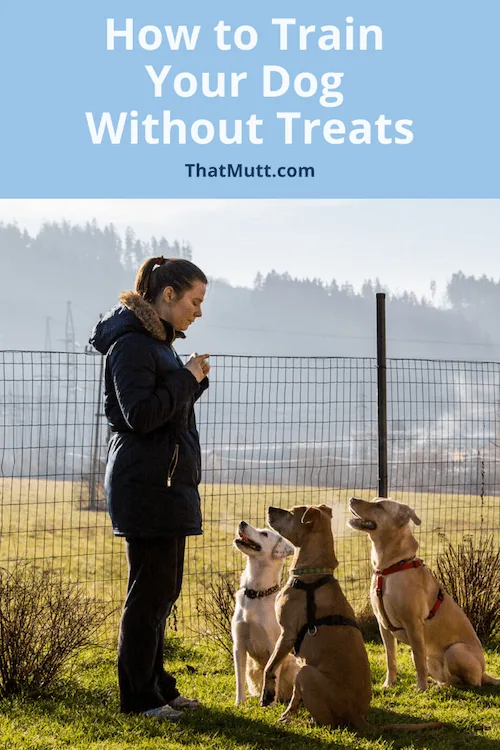
Let us know in the comments!
Julia Preston writes for That Mutt about dog behavior and training, working dogs and life on her farm in Ontario, Canada. She has a sweet, laid-back boxer mix named Baxter. She is also a blogger at Home on 129 Acres where she writes about her adventures of country living and DIY renovating.

Bronwyn
Sunday 24th of May 2020
I like the sound of this. I never used treats for my other 2 dogs but our new puppy is more wilful, so we started obedience training. After one week of practi c e with continuous treats, she now is going off the treats and my commands aren't working. Now I have a to give her higher value treats to get the same result. Something wrong there?
Lindsay Stordahl
Sunday 24th of May 2020
It's up to you and you know her best. I would give fewer treats to keep her guessing when they're coming. Except when leaning something brand new or still learning something, then more treats.
Marisela Giordano
Monday 13th of April 2020
I have been trying intermittent treating with my six month old pup. He is crazy on leash trying to chase every squirrel, dog or bird. He also loves to say hello to people and is very friendly. Today he almost pulled my arm out of my socket. I need to work on the changing direction and making him sit. I was using the clicker to have him turn to look at me and then get a treat. I do want to try the no treat and the changing direction. I need a lot of help and maybe this will work. Will try tomorrow. Love the article and hoping it will work for my pup. Mari
Ellie
Monday 2nd of March 2020
We use treats for fun stuff but not for others, or for Come. My #1 goal from day one is off-leash voice control because of where we live in summer -- there are dangers (cougars, cliffs ...) and they won't be on a leash in the mountains. But it has to happen First, before we even buy a collar, no treats just lavish praise -- start by finding any sounds & gestures that gets the pup to look at me and come nearer (with the new pup it was a squeak and wiggling fingers) while saying Come, and pour on the happy. Inside outside sleepy playing -- often. The second is "HEY!" which becomes "no" gradually, and start on "Easy" which can take weeks. Then Sit with treat by waiting til the butt hit the floor ON her own while I stand there holding the cheerio. Then Down but with a treat leading her from sit along the flour helps her understand faster. "Wait," no treat because its opportunity -- hold my hand up say wait and close the car door, and she lays down with the older dog. Fun stuff like shake or speak needed a treat with all our dogs. When a pup is ok on the leash, I make sure "come" is non negotiatiable, use a longer lead -- make them come and praise on the way, it helps later when I have to keep them from chasing a critter. Our old dog learned to the screen doors by pulling a leather strap I tacked on, no treat -- just in + a happy greeting: first I wiggled the strap and said "get it!" til he touched it then i pull it open for him, soon when i wiggled he'd grab it, eventually he'd pull a bit, later enough. But having just watched a video on touch-stick training i might try it with this new pup, would be fun to have a dog that could close a door! Thanks for this post, the more I learn the more they can.
Sean
Thursday 5th of December 2019
Being a pet owner I have never thought of training my dogs without treats. As most of the time, I reward him with treats for his good behavior and try to correct him if required.
I agree with you that with the help of right trainer we can enforce good habits in our pet. Finding the right trainer is quite difficult, but it can make a lot of difference.
Thanks for sharing the post and I am looking forward to your next post!
Trevor
Saturday 31st of August 2019
I'm a little late to the article, but I am so happy there are folks out there that professionally train without treats. I have never payed for training with my dogs, but I have never had any trouble getting my dogs to a point where hiking off leash is natural. I am certainly not against training with treats, but in my experience, I tend to have a better relationship (mutual respect is probably a better term here) with my dogs than do people around me that have trained with treats. Obviously there are a lot of factors that go into a relationship with any pet, but that is my experience.
I am a big fan of basically everything you said. I do most of that myself. The only thing I would add is training with hand signals. Saying sit is a great tool, but sometimes you are a long ways away, or need to be quiet, or want to make a kid feel like they have "the force". I have been in plenty of scenarios where hand signals (or I should say body signals including hands) have come in very handy. It also forces you and your pet to communicate in a different way which only enhances the relationship in my opinion. Anyway, great article!